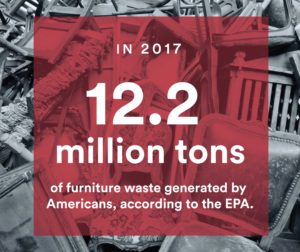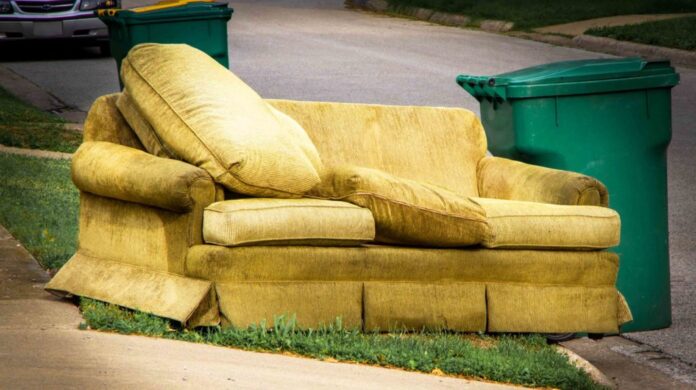Date: November 10, 2020
Author: Unknown
Publisher: TRS
One of the outcomes of the past months is that Americans have been spending a lot more time at home than usual. Faced with extra hours living and often working in the same space, many have been channeling their energy into transforming their homes—creating more comfortable living and working conditions to accommodate the “new normal”.
This has translated into a renovation boom, with sales of home improvement supplies, furniture, and even paint all experiencing positive growth over the course of the year.
But there’s a hidden downside to that home or office makeover: furniture waste. Known in the industry as “f-waste”, furniture waste is often overlooked by businesses and consumers because it’s generated less frequently than other types of waste. Yet furniture waste disposal is highly problematic, and since furniture can’t easily be thrown out or recycled like other types of waste, it often gets dumped illegally, and eight times out of 10 simply ends up in a landfill.
Furniture waste: The facts

According to the EPA, furniture waste generated by Americans in 2017 totaled a staggering 12.2 million tons, and 80.2% of it went to landfill. The agency also found that only 0.3% of the f-waste that was sent to landfill was recovered for recycling. To make matters worse, furniture waste doesn’t include items like carpets and rugs, of which Americans threw away an additional 3.4 million tons in 2017.
Part of the problem is “fast furniture”. Produced and sold by some of the biggest names in the furnishing and home improvement industries, these items are made using poor-quality materials and offered at prices so low that many people consider them disposable.
Combined, the low quality and value of fast furniture mean it’s usually too expensive or difficult to repair, sell, or donate, and it‘s much more likely to end up on the curb than the more expensive, robust furniture of previous generations. In fact, a UK survey found that one-third of people threw away still-functional furniture rather than selling or donating it.
And just like with fast fashion, the culture of fast furniture encourages consumers to update their home decor to follow constantly changing design trends. Tempted by annual catalogs promoting new and updated products, many people are eager to buy new furniture to replace the old, out-of-date pieces they already have.
There’s more to this story than glossy pages full of domestic bliss, however. Office furniture is actually the primary source of f-waste, accounting for an estimated 8.5 million tons of furniture waste per year. And with offices gradually downsizing to accommodate the shift to working from home, this figure is likely to increase over the next few years, at least temporarily.
The problems with furniture waste disposal

So why is disposing of furniture so difficult? The primary factor, particularly with modern furniture, is what it’s made of. A single item is often composed of multiple different materials, including wood, metal, and various types of plastic, many of which are difficult to recycle. Taking furniture apart and processing each type of material separately is time-consuming and expensive.
Rather than solid wood, a lot of furniture also utilizes chipboard, which is made of chopped up pieces of wood sealed together with glues that contain toxic chemicals and is often laminated with plastic. Some older pieces of furniture also contain chemicals that are hazardous for health, like flame retardants. These materials are not only almost impossible to recycle, but also difficult and expensive to dispose of safely.
Reducing furniture waste responsibly
Efforts are being made to reduce furniture waste by using the principles of the circular economy. Ikea, for example, has pledged to vastly reduce its footprint and become a “circular business” by 2030. As part of this initiative, the company is testing a buyback scheme where furniture still in good condition will be resold, and broken or worn-out pieces will be recycled into new Ikea products. There are also a number of startups focusing on furniture that are completely designed around sustainability and circular economies.

But what to do with the unwanted furniture you have now? Will municipal waste management pick up furniture? To avoid f-waste ending up in landfills, reusing and recycling are the two best options. Posting items on online forums like Craigslist or Freecycle is a simple and relatively hassle-free way to find a new owner, and those willing to do a bit more legwork can also find local charities who are happy to accept donated furniture.
In most areas, municipal waste management will pick up furniture, or offer a place for furniture waste drop off, but there’s little guarantee that it will be recycled. To recycle household furniture it’s best to search for a recycling center in your area that can handle f-waste.
Office furniture waste is problematic because of the sheer quantity of it that is generated in a short period. Yet unlike household furniture, office desks, chairs, and even cubicle partitions have many opportunities for a second life at schools and local organizations that may struggle to purchase new furnishings themselves. In some cases, the donated furniture may even make a business eligible for tax deductions, which help offset the costs of waste management.
Comments:
Here we are at last. What I am actually 100% going to do. I think this is a very large problem and can be solved beautifully with large-scale additive manufacturing. With the new BAAM coming out in the next year or two and the rise of trends being able to design then recycle your furniture will be the way of the future.
The sheer amount of furniture waste produced each year shocked me. When I look at furniture I think of something that should last for years even decades. But with our consumer economy, many pieces are going out of style faster than ever, and furniture is becoming even less quality than before.





